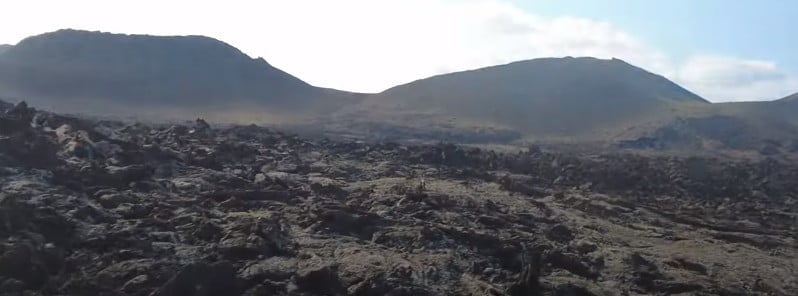Lava field in Lanzarote twice as thick as previously thought, Canary Islands

An international group of researchers reporting in AGU’s Geochemistry, Geophysics, Geosystems used radar satellites to measure how fast parts of the lava fields in Lanzarote, Canary Islands are sinking nearly three centuries after a massive eruption that lasted from 1730 – 1736 (VEI 3). Their results show that when multiple stacked lava flows get very thick (here estimated at over 100 m / 330 feet in thickness), they are still able to continue deforming centuries later.
- The researchers detected multi-decade subsidence of up to 6 mm (0.25 inches) per year across Timanfaya lavas emplaced almost 300 years ago using InSAR time series
- Peak subsidence is consistent with the cooling of 100 – 150 m (330 – 490 feet) thick lava flows
The 1730 – 1736 eruption on Lanzarote was one of the most significant volcanic eruptions to occur on the Canary Islands, with lavas covering over 200 km2 (77 mi2), the authors noted.1
Globally, it is volumetrically the third largest known subaerial basaltic fissure eruption in the past 1 100 years.
The team used Sentinel-1 and ENVISAT interferograms on both ascending and descending orbits to construct a time series of line-of-sight surface displacements and calculate linear vertical deformation rates.
“We resolve a constant subsidence rate of about 6 mm/yr [0.25 inches/yr] associated with an area of ∼20 km2 [7.7 mi2] within the central and western portion of the Timanfaya lava flows relative to the rest of the island.
This is consistent over the 28-year period (1992–2020) covered by the Sentinel-1 and ENVISAT data when combined with the previously published ERS data.
“Time series constructed using Sentinel-1 short interval interferograms have previously been shown to suffer systematic biases and we find that by making longer period interferograms these biases can be mitigated (when compared against an averaged stack of 1-year interferograms).”
Cooling-driven contraction of an intrusion would require an improbably large sill thickness to achieve the observed subsidence rates.
“Our observations are consistent with the cooling of lavas on the order of one hundred meters, twice as thick as previous estimates, which suggests overall lava volume for this eruption may have been underestimated,” the authors said. “This is also evidence of the longest duration of lava flow subsidence ever imaged which indicates that these cumulative thick flows can continue to deform significantly even three centuries after emplacement.”
As the authors themselves recall, the last eruption in the Canary Islands, that of Cumbre Vieja, of much lesser importance (although with greater damage, because it devastated a densely populated area) left lava fields with thicknesses of up to 60 m (200 feet).2
Geological summary
The 60 km (37 miles) long island of Lanzarote at the NE end of the Canary Islands contains the largest concentration of youthful volcanism in the Canaries.
Pleistocene-and-Holocene cinder cones and lava flows erupted along NE-SW fissures are found throughout the low-altitude arid island and on smaller islands to the north.
The largest historical eruption of the Canary Islands took place during 1730-36, when long-term eruptions from a fissure formed the Montañas del Fuego and produced voluminous lava flows that covered about 200 km2 (77 mi2).
The lava flows reached the western coast along a broad, 20 km (12 miles) wide front. The villages of Maretas and Santa Catalina were destroyed, along with the most fertile valleys and estates on the island.
An eruption during 1824 produced a much smaller lava flow that reached the SW coast.
This volcano is located within the Lanzarote and Chinijo Islands, a UNESCO Global Geopark property.3
References:
1 Nearly three centuries of Lava Flow Subsidence at Timanfaya, Lanzarote – AGU Geochemistry, Geophysics, Geosystems – October 8, 2022 – https://doi.org/10.1029/2022GC010576 – FREE ACCESS
2 The Timanfaya lavas shrink 0.6 centimeters a year and three centuries later they continue to cool – Diario de Lanzarote – October 17, 2022
3 Lanzarote – Geological summary – GVP
Featured image credit: The Netherlands and Beyond (stillshot)

Commenting rules and guidelines
We value the thoughts and opinions of our readers and welcome healthy discussions on our website. In order to maintain a respectful and positive community, we ask that all commenters follow these rules.